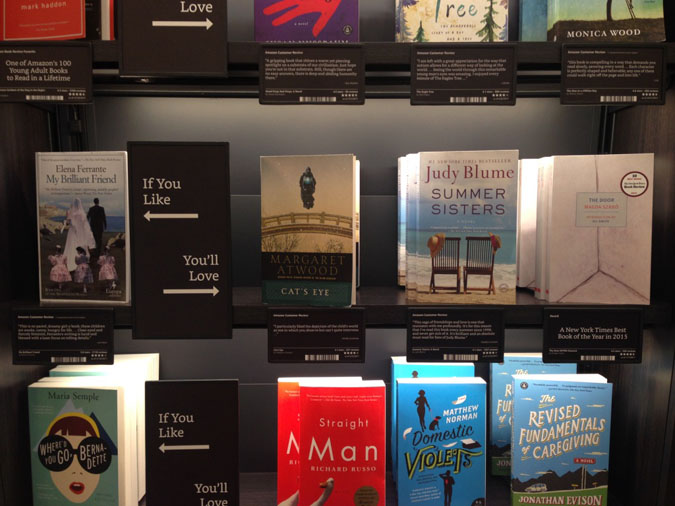In my travels as a messaging consultant I often got a sneak peek into emerging business trends. A couple of years ago I helped Wipro and FedEx create messaging for omnichannel retail. Though they were entering the market from different angles both companies had the same goal. They wanted to help big retailers sell, and ensure customers could buy and exchange, products using all available retail channels: a physical store, online, the phone, and whatever comes next.

Amazon Echoes for sale in Whole Foods
My, how these omnichannel seeds have grown. In late August Amazon celebrated their takeover of Whole Foods by lowering prices at the grocery chain. I’m not a big Amazon customer but I am a big Whole Foods shopper, and have been for some time. In New York City both entities have physical stores in Columbus Circle right near where I’m working these days. On a slow grey day at work, I went to check out the future of retail on a lunch break.
Amazon moved right in at Whole Foods
As I got off the escalator at Whole Foods there was no question Amazon had moved right in. A display filled with Amazon Echoes and Echo Dots were the “Farm Fresh Pick of the Season”; both were on sale for $99.99 and $44.99, respectively. I also went to check out other items I’d read about that now have lower prices. A pack of salmon portions costs what it did a couple of years ago, rotisserie chicken was about a dollar less than it was the Friday before, and pricey organic eggs were a little cheaper.

Amazon is growing something good in Whole Foods
I rotate my grocery shopping between Whole Foods, some bodegas, and a smaller grocery store in my neighborhood, so I feel qualified to detect any major changes at Whole Foods. The verdict? Apart from signage and prominent Amazon Echo display, Whole Foods didn’t feel all that different. Until more prices are cut, my grocery bills won’t feel much different, either. The “We’re Growing Something Good” sign near the exit made me think they’re just getting started at integrating their messaging. As I wondered if the price drops would continue I made my way upstairs, curious to see what was going on in the Amazon Bookstore.
Customer data on display at the Amazon Bookstore
Like I said, I’m not a big Amazon person. I do buy stuff from them, but not enough to justify getting an Amazon Prime Account. I visited the physical Amazon Bookstore right after it opened and ended up liking it much more than I thought I would. I loved that Amazon kept books as the store’s focus—it’s a nice nod to its roots, and since I love a good bookstore, there’s a higher chance I’ll buy from Amazon here. I also admired how they integrated non-book items. There’s a whole Kindle section, and they’d sprinkled other assorted best-selling items throughout the store in a subtle, unobtrusive way.
On my return visit I didn’t see any items from Whole Foods on the shelves but man oh man, the store continues to be a case study in omnichannel retail.

If you like/you’ll love: how to buy books in the Amazon retail store
They’ve translated their online presence into their brick and mortar store brilliantly: It’s your friendly neighborhood bookstore whose shelves radiate with the glossy sheen of all the customer data Amazon has been mining for years. In addition to traditional categories such as “Fiction” and “Poetry,” you can browse books by and “Fiction Top Sellers in New York” rather than “Hardcover/Paperback Fiction Best Sellers from the New York Times.” They also have a neat “If You Like/You’ll Love” section featuring books of all genres. A sign explained that paperback releases are selected based on pre-orders, sales, and popularity on Goodreads, underscoring the relationship Amazon has with its customers. They had back-to-school items scattered throughout the store, and plenty of non-book items to peruse as you browse the books.

Prices explained at the Amazon retail store (hint: good to be a Prime Member)
While the stores aren’t “one” yet, I can see how things may shake out down the road. In the bookstore, prices aren’t very prominent. You can scan a book using the Amazon app to see the retail and Amazon price, and Amazon customers can pay the Amazon price at checkout. I can see this making its way to Whole Foods very soon—and I wonder when the allure of discounts will strong-arm me into joining Amazon Prime. The Amazon Bookstore doesn’t take cash though, so I’ll wait and see if my love for cash and keeping some of my buying habits hidden from the Retail Eye keeps me from embracing the discount angle.